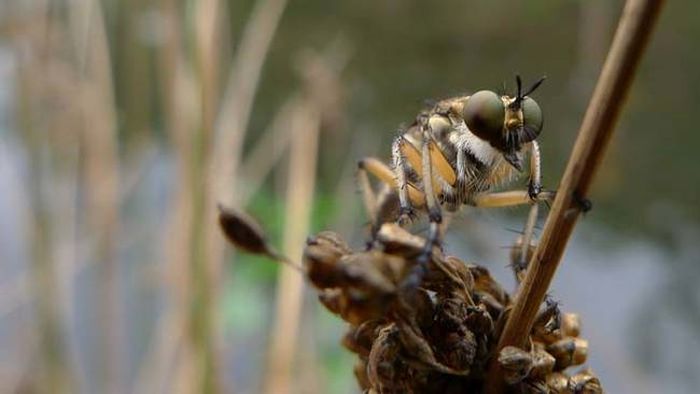|
|
Asilidae, Assassin Robber Fly
|
Much better known and described in detail is the behavior of adults. In general, the activity of predation of adults is concentrated in the hottest hours in open, sunny spaces, while at night they take refuge in the dense vegetation. The Asilidae are excellent flyers and, in most of the family, they capture prey in flight; other behaviors,are found, however and Asilidae are often seen stationed to ambush prey at strategic points. This behavior signifies that the sight plays an essential role in the detection of prey and their capture. The prey is caught with the tarsi and immobilized as a result of the paralysis caused by the injection of saliva. The asilid pierces the integument of the prey with the prepharyx (hyopharynx) in preferential points of least resistance as the eyes, the membranous area of transition between the head and thorax (neck) or between thorax and abdomen, or between the last urotergiti. Puncture is followed by the injection of saliva, whose active components perform two functions: the neurotoxins cause paralysis of the victim, while proteolytic enzymes lead to the breakup and liquefaction of internal tissues, in a short time the predator is able to feed sucking the internal fluids through the alimentary canal.
With regard to interspecific trophic relationships, there is a large number of reports on the prey captured by Asilidae. Lavigne (2003) has developed a database comprising over 13,000 reports Lavigne (2003). The prey of Asilidi are predominantly represented by other insects, mostly winged, but several cases in which they have attacked spiders have also been reported. Within the insects, orders that include the most frequent prey of asilids are the beetles, the Hymenoptera, the Diptera, the Hemiptera and Lepidoptera, with a wide range of families, but prey belonging to various other orders (Odonata, Neuroptera, Isoptera, Thysanoptera, Blattodea, etc.) are also mentioned.
With regard to the specificity of the trophic relationship Wood (1981) mentions the existence of some studies in the literature on the subject.Some genera have been found to be monophagic, but more generally the Asilidae manifest a more or less wide polyphagia with behaviors that vary from stenophagia to euriphagia. However, there are cases of stenohage asilids which if necessary focus their predatory activity against a species when this forms large populations.
Other studies conducted by Dennis, D. and Lavigne,(1975) have shown that the ratio between the size of the prey and the asilid varies from 1.8:1 to 3.7:1, with an average of 2. 6:1. The ratio tends to increase with decreasing size of the predator.
|
|









